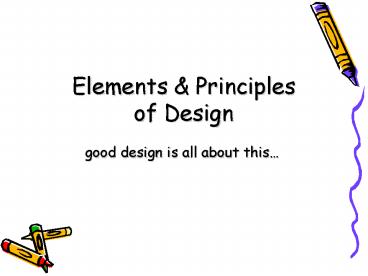Elements PowerPoint PPT Presentation
1 / 29
Title: Elements
1
Elements Principles of Design
- good design is all about this
2
What Are They?
- Elements of design are the parts.
- They structure and carry the work.
- Principles of design are concepts.
- They affect content and message.
3
The Elements of Design
- These 6 ingredients are used to create a design
- 1.shape
- 2.space
- 3.line
- 4.texture
- 5.value
- 6.colour
4
The Principles of Design
- The principles are how you decide to put all the
elements together. - You can make a zillion choices when doing this.
5
The Principles of Design
- 1. proportion
- 2. balance (symmetry)
- 3. rhythm / pattern
- 4. emphasis (focal point)
- 5. variety
- 6. contrast
- 7. unity
- 8. movement
6
Line
- Line is a moving dot.
7
Form and Space
- Form is an area surrounded by space.
- Space can be positive or negative.
8
Movement
- Movement is the relocation of an object
- in space over time.
9
Color
- Color is the hue, shade, or tone
- of an object.
10
Texture
- Texture is the visual surface quality
- of an object.
11
Direction
- Direction is the course along
- which a line moves.
12
Proportion
- Proportion is the relative size
- and scale of elements in a design.
13
Balance
- Balance relates to our physical
- sense of balance.
14
Gradation
- Gradation is the change from
- one color to another.
15
Repetition
- Repetition is one, or similar elements
- that are repeated.
16
Contrast
- Contrast is when elements are different.
17
Harmony
- Harmony is when elements are related.
18
Dominance
- Dominance is when one object is emphasized more
than another.
19
Rhythm
- Rhythm is a measured movement
- through space.
20
Unity and Variety
- Unity is a set of elements from the
- same family. Variety is elements that
- are similar, but not the same.
21
Examples
This image uses the elements of shape, space,
colour, value texture. The principles used here
are repetition, variety of proportion, contrast
(light vs. dark) , movement and rhythm.
22
The trick is to be able to explain how they (the
principles are used). Ie Here we have a pattern
inifying the background, bright variety of colour
across the foreground, a large central face is
emphasized and there is a sense of repeated
pattern by the three front figures (essentially
the same pose).
23
Your Turn!
- What elements and principles do
- you see being used in this image?
24
Sources
- Jirousek, C. (1995). Elements of Design. In Art,
Design, and Visual Thinking. Retrieved September
28, 2009, from - http//www.char.txa.cornell.edu.
- Lovett, J. (1999). Elements and Principles of
Design. In John Lovett Watercolor and Mixedmedia
Artist. Retrieved September 28, 2009, from
http//www.johnlovett.com/test.htm - Line Mike Chaput-Branson, Line Up The Color
January 19, 2008 via Flickr, Creative Commons
Attribution, Noncommercial, Share Alike License. - Form and Space Ntr23, Ice Form August 19, 2006
via Flickr, Creative Commons Attribution,
Noncommercial, Share Alike License.
25
Image Sources
- Movement Ed Schipul, Orange Line _at_ eTech 2007
March 28, 2007 via Flickr, Creative Commons
Attribution, Share Alike License. - Color Nasplayer, Rainbow Colored Milk Drop
Splash (Explore 108) June 11, 2009 via Flickr,
Creative Commons Attribution, No Derivative
Works License. - Texture Lucy Nieto, Tapete de Plástico 2007
November 24, 2007 via Flickr, Creative Commons
Attribution, Noncommercial, Share Alike License. - Direction Jeff Bauche, Abstract Life Line
January 21, 2008 via Flickr, Creative Commons
Attribution, Noncommercial, No Derivative Works
License. - Proportion Alper Çugun, Disproportion July 4,
2007 via Flickr, Creative Commons Attribution,
Noncommercial License.
26
Image Sources
- Balance Terence T.S. Tam, Space Needle and
Pacific Science Center October 6, 2008 via
Flickr, Creative Commons Attribution,
Noncommercial, Share Alike License. - Gradation Natrium Chlorine, IMGP4383a2 October
18, 2008 via Flickr, Creative Commons
Attribution, Noncommercial, Share Alike License. - Repetition Kevin Dooley, Angles, Lines, Light,
and Shadows November 7, 2007 via Flickr,
Creative Commons Attribution License. - Contrast CatalineOlavarria, Al Fondo a la
Derecha September 2, 2006 via Flickr, Creative
Commons Attribution, Noncommercial, Share Alike
License.
27
Image Sources
- Harmony Kris De Curtis, Christmas in Love
December 12, 2007 via Flickr, Creative Commons
Attribution, Noncommercial, No Derivative Works
License. - Dominance Toshihiro Oimatsu, Emphasis June 23,
2009 via Flickr, Creative Commons Attribution
License. - Rhythm ZeroOne, Spiral Staircase July 2, 2007
via Flickr, Creative Commons Attribution, Share
Alike License. - Variety Ross Orr, Series VI September 26, 2007
via Flickr, Creative Commons Attribution,
Noncommercial, No Derivative Works License. - Your Turn! RomnickSimplicio, Africa Fighting
Below the Line - Print Ad (Education) June 24,
2008 via Flickr, Creative Commons Attribution,
Noncommercial, No Derivative Works License.
28
Principles and Elements of Design
29
proportion balance (symmetry) rhythm /
pattern emphasis (focal point) variety contrast
unity movement
shape - form space distance in and between line
thin, long mark made by something texture
look/feel value degree of lightness, darkness,
intensity colour

